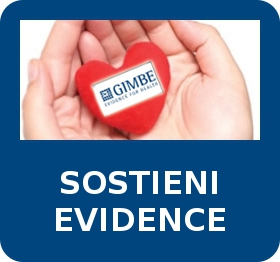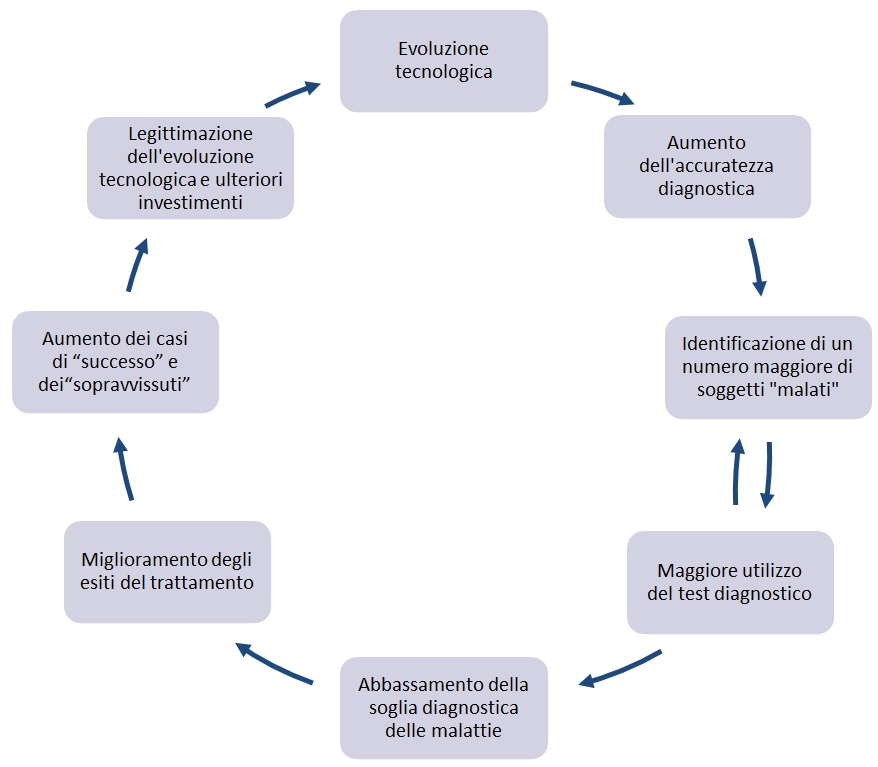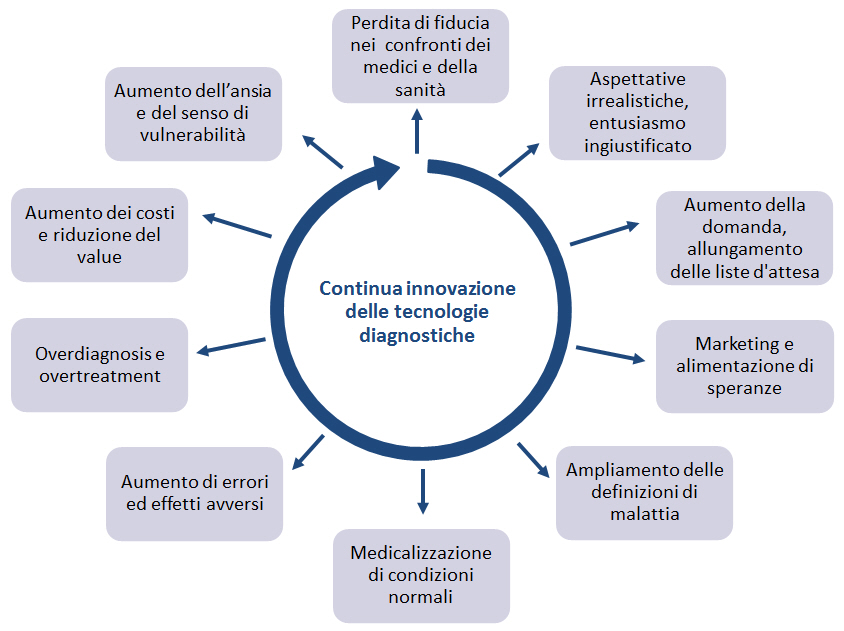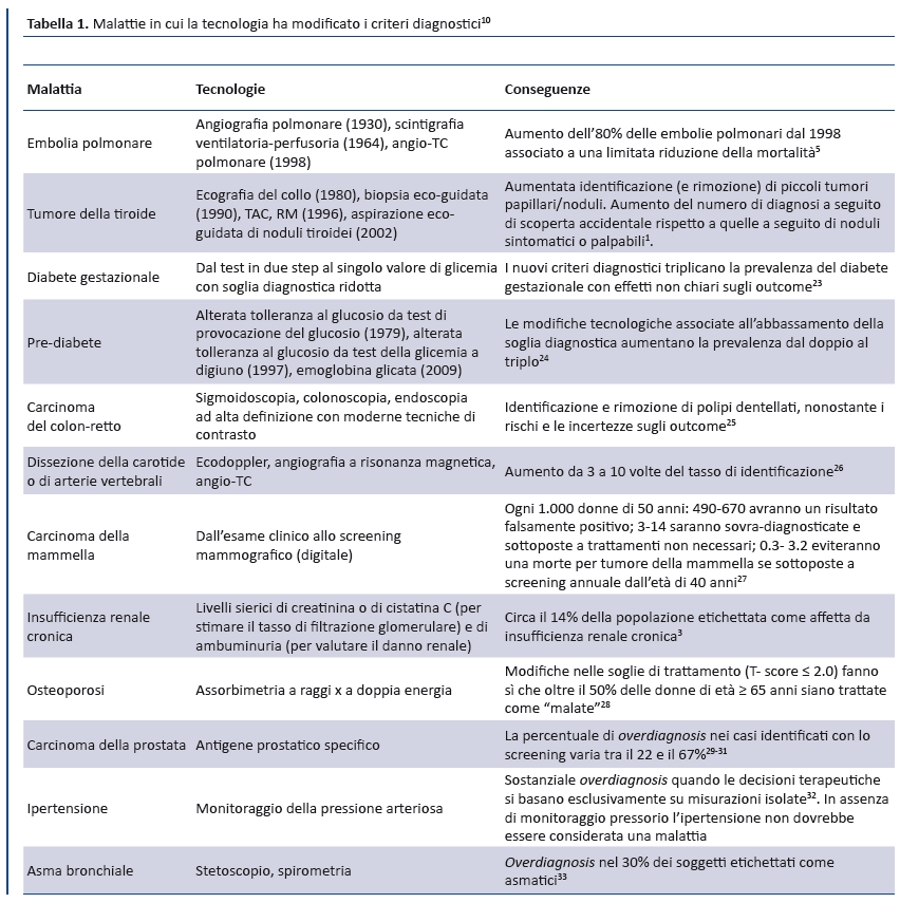Less is More
La corsa all’armamento tecnologico: affannosa, costosa e rischiosa
Antonino CartabellottaEvidence 2015;7(7): e1000116 doi: 10.4470/E1000116
Pubblicato: 8 luglio 2015
Copyright: © 2015 Cartabellotta. Questo è un articolo open-access, distribuito con licenza Creative Commons Attribution, che ne consente l’utilizzo, la distribuzione e la riproduzione su qualsiasi supporto esclusivamente per fini non commerciali, a condizione di riportare sempre autore e citazione originale.
1. Brito JP, Morris JC, Montori VM. Thyroid cancer: zealous imaging has increased detection and treatment of low risk tumours. BMJ 2013;347:f4706.
2. Moynihan R. Science of overdiagnosis to be served up with a good dose of humility. BMJ 2013;347:f5157.
3. Moynihan R, Glassock R, Doust J. Chronic kidney disease controversy: how expanding definitions are unnecessarily labelling many people as diseased. BMJ 2013;347:f4298.
4. Welch HG, Schwartz L, Woloshin S. Overdiagnosed: making people sick in the pursuit of health . Beacon Press, 2011.
5. Wiener RS, Schwartz LM, Woloshin S. When a test is too good: how CT pulmonary angiograms find pulmonary emboli that do not need to be found. BMJ 2013;347:f3368.
6. Le Couteur DG, Doust J, Creasey H, Brayne C. Political drive to screen for pre-dementia: not evidence based and ignores the harms of diagnosis. BMJ 2013;347:f5125.
7. Moynihan R, Smith R. Too much medicine? BMJ 202;324:859-60.
8. Richards P. Too much medicine? BMJ 1999;318:268.
9. Brownlee S. Overtreated: why too much medicine is making us sicker and poorer: Bloomsbury, 2007.
10. Moynihan R, Doust J, Henry D. Preventing overdiagnosis: how to stop harming the healthy. BMJ 2012;344:e3502.
11. Payer L. Disease-mongers: how doctors, drug companies, and insurers are making you feel sick: Wiley, 2006.
12. Illich I. Limits to medicine . Penguin, 1976.
13. Bodenheimer T. High and rising health care costs. Part 2: technologic innovation. Ann Intern Med 2005;142:932-7.
14. Prevention CfDCa. Health, United States, 2009 with special feature on medical technology. US Department of Health and Human Services, 2009.
15. Dybczak K, Przywara B. The role of technology on health care expenditure in the EU. European Economy-Economic Paper 400. Directorate General for Economic and Monetary Affairs, 2010.
16. Sorenson C, Drummond M, Bhuiyan Khan B. Medical technology as a key driver of rising health expenditure: disentangling the relationship. ClinicoEconomics and Outcomes Research 2013;5:223-34.
17. Carrier ER, Dowling M, Berenson RA. Hospitals’ geographic expansion in quest of well-insured patients: will the outcome be better care, more cost, or both? Health Affairs (Project Hope) 2012;31:827-35.
18. Fisher ES, Welch HG. Avoiding the unintended consequences of growth in medical care: how might more be worse? JAMA 1999;281:446-53.
19. Fryback DG, Thornbury JR. The efficacy of diagnostic imaging. Med Decision Making 1991;11:88-94.
20. Burge AJ, Freeman KD, Klapper PJ, Haramati LB. Increased diagnosis of pulmonary embolism without a corresponding decline in mortality during the CT era. Clin Radiol 2008;63:381-6.
21. Moynihan RN, Cooke GP, Doust JA, Bero L, Hill S, Glasziou PP. Expanding disease definitions in guidelines and expert panel ties to industry: a cross-sectional study of common conditions in the United States. PLoS Med 2013;10:e1001500.
22. Black WC, Welch HG. Advances in diagnostic imaging and overestimations of disease prevalence and the benefits of therapy. N Engl J Med 1993;328:1237-43.
23. Cundy T, Ackermann E, Ryan EA. Gestational diabetes: new criteria may triple the prevalence but effect on outcomes is unclear. BMJ 2014;348:g1567.
24. Yudkin JS, Montori VM. The epidemic of pre-diabetes: the medicine and the politics. BMJ 2014;349:g4485.
25. Hoff G, Bretthauer M, Garborg K, Eide TJ. New polyps, old tricks: controversy about removing benign bowel lesions. BMJ 2013;347:f5843.
26. Provenzale JM, Sarikaya B. Comparison of test performance characteristics of MRI, MR angiography, and CT angiography in the diagnosis of carotid and vertebral artery dissection: a review of the medical literature. Am J Roent 2009;193:1167-74.
27. Welch HG, Passow HJ. Quantifying the benefits and harms of screening mammography.JAMA Intern Med 2014;174:448-54.
28. Herndon MB, Schwartz LM, Woloshin S, Welch HG. Implications of expanding disease definitions: the case of osteoporosis. Health Aff 2007;26:1702-11.
29. De Carvalho TM, Heijnsdijk EA, de Koning HJ. Screening for prostate cancer in the US? Reduce the harms and keep the benefit. Int J Cancer 2015;136:1600-7.
30. Loeb S, Bjurlin MA, Nicholson J, Tammela TL, Penson DF, Carter HB, et al. Overdiagnosis and overtreatment of prostate cancer. Eur Urol 2014;65:1046-55.
31. Sandhu GS, Andriole GL. Overdiagnosis of prostate cancer. J Natl Cancer Inst Mono 2012;45:146-51.
32. Hodgkinson J, Mant J, Martin U, Guo B, Hobbs FD, Deeks JJ, et al. Relative effectiveness of clinic and home blood pressure monitoring compared with ambulatory blood pressure monitoring in diagnosis of hypertension: systematic review. BMJ 2011;342:d3621.
33. Luks VP, Vandemheen KL, Aaron SD. Confirmation of asthma in an era of overdiagnosis. Eur Resp J 2010;36:255-60.
34. Appleby J, Raleigh V, Frosini F, Bevan G, Gao H, Lyscom T. Variation in healthcare. King’s Fund, 2011.
35. Wennberg E. Tracking medicine . Oxford University Press, 2010.
36. Lin GA, Dudley RA, Redberg RF. Why physicians favor use of percutaneous coronary intervention to medical therapy: a focus group study. J Gen Intern Med 2008;23:1458-63.
37. Augsburger JJ. Unnecessary clinical tests in ophthalmology. Trans Am Ophthalmol Soc 2005;103:143-6; discussion 46-7.
38. Gabbay J, Walley T. Introducing new health interventions. BMJ 2006;332:64-5.
39. Pedersen T, Nicholson A, Hovhannisyan K, Moller AM, Smith AE, Lewis SR. Pulse oximetry for perioperative monitoring. Cochrane Database Syst Rev 2014;3:CD002013.
40. Ho C, Tsakonas E, Tran K, Cimon K, Severn M, Mierzwinski-Urban M et al. Robot-assisted surgery compared with open surgery and laparoscopic surgery. Clinical effectiveness and economic analyses. Canadian Agency for Drugs and Technologies in Health, 2011.
41. Haas M, Hall J, Viney R, Gallego G. Breaking up is hard to do: why disinvestment in medical technology is harder than investment. Austr Health Rev 2012;36:148-52.
42. Henshall C, Schuller T, Mardhani-Bayne L. Using health technology assessment to support optimal use of technologies in current practice: the challenge of “disinvestment.” Int J Technol Assess Health Care 2012;28:203-10.
43. Fuchs VR, Sox HC Jr. Physicians’ views of the relative importance of thirty medical innovations. Health Aff (Project Hope) 2001;20:30-42.
44. Luft HS, Robinson JC, Garnick DW, Maerki SC, McPhee SJ. The role of specialized clinical services in competition among hospitals. Inquiry 1986;23:83-94.
45. Hofmann B. When means become ends: technology producing values. Seminar.net 2006;2. http://seminar.net/index.php/volume-2-issue-2-2006-previousissuesmeny-114/66-when-means-become-ends-technology-producing-values.
46. Album D, Westin S. Do diseases have a prestige hierarchy? A survey among physicians and medical students. Soc Sci Med 2008;66:182-8.
47. Wolf S, Berle B. The technological imperative in medicine . Plenum Press, 1981.
48. Moynihan R, Heath I, Henry D. Selling sickness: the pharmaceutical industry and disease mongering. BMJ 2002;324:886-91.
49. Cassell E. The sorcerer’s broom. Medicine’s rampant technology. Hastings Center Report 1993;23:32-9.
50. Winner L. Autonomous technology . MIT Press, 1977.
51. Hofmann B. Is there a technological imperative in health care? Int J Technol Assess Health Care 2002;18:675-89.
52. Davis A. Medicine and its technology. An introduction to the history of medical instrumentation . Greenwood, 1981.
53. Boenink M. Molecular medicine and concepts of disease: the ethical value of a conceptual analysis of emerging biomedical technologies. Med Health Care Philos 2010;13:11-23.
54. Hofmann B. The technological invention of disease—on disease, technology and values. University of Oslo, 2002.
55. Prasad V, Rho J, Cifu A. The diagnosis and treatment of pulmonary embolism: a metaphor for medicine in the evidence-based medicine era. Arch Intern Med 2012;172:955-8.
56. Brito JP, Gionfriddo M, Morris JC, Montori VM. Overdiagnosis of thyroid cancer and Graves’ disease. Thyroid 2014;24:402-3.
57. Welch HG, Black WC. Overdiagnosis in cancer. J Natl Cancer Inst 2010;102:605-13.
58. Welch HG, Woloshin S, Schwartz L. Overdiagnosed: making people sick in pursuit of health. Beacon Press, 2011.
59. Colla CH, Morden NE, Sequist TD, Schpero WL, Rosenthal MB. Choosing wisely: prevalence and correlates of low-value health care services in the United States. J Gen Intern Med 2015;30:221-8.
60. Collado M. How prevalent and costly are Choosing Wisely low-value services? Evidence from Medicare beneficiaries. Find Brief 2014;42:1-2.
61. National Institute for Health and Care Excellence. NICE “do not do” recommendations. NICE, 2011.
62. Heidegger M. The question concerning technology and other essays . Harper and Row, 1977.
63. Hofmann B. On the value-ladenness of technology in medicine. Med Health Care Philos 2001;4:335-46
64. Latour B. Reassembling the social: an introduction to actor-network-theory . Oxford University Press, 2005.
65. Chernew ME, Jacobson PD, Hofer TP, Aaronson KD, Fendrick AM. Barriers to constraining health care cost growth. Health Aff (Project Hope) 2004;23:122-8.
66. Wilmshurst P. The regulation of medical devices. Unsatisfactory, unscientific, and in need of a major overhaul. BMJ 2011;342:d2822.
67. Dhruva SS, Bero LA, Redberg RF. Strength of study evidence examined by the FDA in premarket approval of cardiovascular devices. JAMA 2009;302:2679-85.
68. Hofman BM. Too much technology BMJ 2015;350:h705.
2. Moynihan R. Science of overdiagnosis to be served up with a good dose of humility. BMJ 2013;347:f5157.
3. Moynihan R, Glassock R, Doust J. Chronic kidney disease controversy: how expanding definitions are unnecessarily labelling many people as diseased. BMJ 2013;347:f4298.
4. Welch HG, Schwartz L, Woloshin S. Overdiagnosed: making people sick in the pursuit of health . Beacon Press, 2011.
5. Wiener RS, Schwartz LM, Woloshin S. When a test is too good: how CT pulmonary angiograms find pulmonary emboli that do not need to be found. BMJ 2013;347:f3368.
6. Le Couteur DG, Doust J, Creasey H, Brayne C. Political drive to screen for pre-dementia: not evidence based and ignores the harms of diagnosis. BMJ 2013;347:f5125.
7. Moynihan R, Smith R. Too much medicine? BMJ 202;324:859-60.
8. Richards P. Too much medicine? BMJ 1999;318:268.
9. Brownlee S. Overtreated: why too much medicine is making us sicker and poorer: Bloomsbury, 2007.
10. Moynihan R, Doust J, Henry D. Preventing overdiagnosis: how to stop harming the healthy. BMJ 2012;344:e3502.
11. Payer L. Disease-mongers: how doctors, drug companies, and insurers are making you feel sick: Wiley, 2006.
12. Illich I. Limits to medicine . Penguin, 1976.
13. Bodenheimer T. High and rising health care costs. Part 2: technologic innovation. Ann Intern Med 2005;142:932-7.
14. Prevention CfDCa. Health, United States, 2009 with special feature on medical technology. US Department of Health and Human Services, 2009.
15. Dybczak K, Przywara B. The role of technology on health care expenditure in the EU. European Economy-Economic Paper 400. Directorate General for Economic and Monetary Affairs, 2010.
16. Sorenson C, Drummond M, Bhuiyan Khan B. Medical technology as a key driver of rising health expenditure: disentangling the relationship. ClinicoEconomics and Outcomes Research 2013;5:223-34.
17. Carrier ER, Dowling M, Berenson RA. Hospitals’ geographic expansion in quest of well-insured patients: will the outcome be better care, more cost, or both? Health Affairs (Project Hope) 2012;31:827-35.
18. Fisher ES, Welch HG. Avoiding the unintended consequences of growth in medical care: how might more be worse? JAMA 1999;281:446-53.
19. Fryback DG, Thornbury JR. The efficacy of diagnostic imaging. Med Decision Making 1991;11:88-94.
20. Burge AJ, Freeman KD, Klapper PJ, Haramati LB. Increased diagnosis of pulmonary embolism without a corresponding decline in mortality during the CT era. Clin Radiol 2008;63:381-6.
21. Moynihan RN, Cooke GP, Doust JA, Bero L, Hill S, Glasziou PP. Expanding disease definitions in guidelines and expert panel ties to industry: a cross-sectional study of common conditions in the United States. PLoS Med 2013;10:e1001500.
22. Black WC, Welch HG. Advances in diagnostic imaging and overestimations of disease prevalence and the benefits of therapy. N Engl J Med 1993;328:1237-43.
23. Cundy T, Ackermann E, Ryan EA. Gestational diabetes: new criteria may triple the prevalence but effect on outcomes is unclear. BMJ 2014;348:g1567.
24. Yudkin JS, Montori VM. The epidemic of pre-diabetes: the medicine and the politics. BMJ 2014;349:g4485.
25. Hoff G, Bretthauer M, Garborg K, Eide TJ. New polyps, old tricks: controversy about removing benign bowel lesions. BMJ 2013;347:f5843.
26. Provenzale JM, Sarikaya B. Comparison of test performance characteristics of MRI, MR angiography, and CT angiography in the diagnosis of carotid and vertebral artery dissection: a review of the medical literature. Am J Roent 2009;193:1167-74.
27. Welch HG, Passow HJ. Quantifying the benefits and harms of screening mammography.JAMA Intern Med 2014;174:448-54.
28. Herndon MB, Schwartz LM, Woloshin S, Welch HG. Implications of expanding disease definitions: the case of osteoporosis. Health Aff 2007;26:1702-11.
29. De Carvalho TM, Heijnsdijk EA, de Koning HJ. Screening for prostate cancer in the US? Reduce the harms and keep the benefit. Int J Cancer 2015;136:1600-7.
30. Loeb S, Bjurlin MA, Nicholson J, Tammela TL, Penson DF, Carter HB, et al. Overdiagnosis and overtreatment of prostate cancer. Eur Urol 2014;65:1046-55.
31. Sandhu GS, Andriole GL. Overdiagnosis of prostate cancer. J Natl Cancer Inst Mono 2012;45:146-51.
32. Hodgkinson J, Mant J, Martin U, Guo B, Hobbs FD, Deeks JJ, et al. Relative effectiveness of clinic and home blood pressure monitoring compared with ambulatory blood pressure monitoring in diagnosis of hypertension: systematic review. BMJ 2011;342:d3621.
33. Luks VP, Vandemheen KL, Aaron SD. Confirmation of asthma in an era of overdiagnosis. Eur Resp J 2010;36:255-60.
34. Appleby J, Raleigh V, Frosini F, Bevan G, Gao H, Lyscom T. Variation in healthcare. King’s Fund, 2011.
35. Wennberg E. Tracking medicine . Oxford University Press, 2010.
36. Lin GA, Dudley RA, Redberg RF. Why physicians favor use of percutaneous coronary intervention to medical therapy: a focus group study. J Gen Intern Med 2008;23:1458-63.
37. Augsburger JJ. Unnecessary clinical tests in ophthalmology. Trans Am Ophthalmol Soc 2005;103:143-6; discussion 46-7.
38. Gabbay J, Walley T. Introducing new health interventions. BMJ 2006;332:64-5.
39. Pedersen T, Nicholson A, Hovhannisyan K, Moller AM, Smith AE, Lewis SR. Pulse oximetry for perioperative monitoring. Cochrane Database Syst Rev 2014;3:CD002013.
40. Ho C, Tsakonas E, Tran K, Cimon K, Severn M, Mierzwinski-Urban M et al. Robot-assisted surgery compared with open surgery and laparoscopic surgery. Clinical effectiveness and economic analyses. Canadian Agency for Drugs and Technologies in Health, 2011.
41. Haas M, Hall J, Viney R, Gallego G. Breaking up is hard to do: why disinvestment in medical technology is harder than investment. Austr Health Rev 2012;36:148-52.
42. Henshall C, Schuller T, Mardhani-Bayne L. Using health technology assessment to support optimal use of technologies in current practice: the challenge of “disinvestment.” Int J Technol Assess Health Care 2012;28:203-10.
43. Fuchs VR, Sox HC Jr. Physicians’ views of the relative importance of thirty medical innovations. Health Aff (Project Hope) 2001;20:30-42.
44. Luft HS, Robinson JC, Garnick DW, Maerki SC, McPhee SJ. The role of specialized clinical services in competition among hospitals. Inquiry 1986;23:83-94.
45. Hofmann B. When means become ends: technology producing values. Seminar.net 2006;2. http://seminar.net/index.php/volume-2-issue-2-2006-previousissuesmeny-114/66-when-means-become-ends-technology-producing-values.
46. Album D, Westin S. Do diseases have a prestige hierarchy? A survey among physicians and medical students. Soc Sci Med 2008;66:182-8.
47. Wolf S, Berle B. The technological imperative in medicine . Plenum Press, 1981.
48. Moynihan R, Heath I, Henry D. Selling sickness: the pharmaceutical industry and disease mongering. BMJ 2002;324:886-91.
49. Cassell E. The sorcerer’s broom. Medicine’s rampant technology. Hastings Center Report 1993;23:32-9.
50. Winner L. Autonomous technology . MIT Press, 1977.
51. Hofmann B. Is there a technological imperative in health care? Int J Technol Assess Health Care 2002;18:675-89.
52. Davis A. Medicine and its technology. An introduction to the history of medical instrumentation . Greenwood, 1981.
53. Boenink M. Molecular medicine and concepts of disease: the ethical value of a conceptual analysis of emerging biomedical technologies. Med Health Care Philos 2010;13:11-23.
54. Hofmann B. The technological invention of disease—on disease, technology and values. University of Oslo, 2002.
55. Prasad V, Rho J, Cifu A. The diagnosis and treatment of pulmonary embolism: a metaphor for medicine in the evidence-based medicine era. Arch Intern Med 2012;172:955-8.
56. Brito JP, Gionfriddo M, Morris JC, Montori VM. Overdiagnosis of thyroid cancer and Graves’ disease. Thyroid 2014;24:402-3.
57. Welch HG, Black WC. Overdiagnosis in cancer. J Natl Cancer Inst 2010;102:605-13.
58. Welch HG, Woloshin S, Schwartz L. Overdiagnosed: making people sick in pursuit of health. Beacon Press, 2011.
59. Colla CH, Morden NE, Sequist TD, Schpero WL, Rosenthal MB. Choosing wisely: prevalence and correlates of low-value health care services in the United States. J Gen Intern Med 2015;30:221-8.
60. Collado M. How prevalent and costly are Choosing Wisely low-value services? Evidence from Medicare beneficiaries. Find Brief 2014;42:1-2.
61. National Institute for Health and Care Excellence. NICE “do not do” recommendations. NICE, 2011.
62. Heidegger M. The question concerning technology and other essays . Harper and Row, 1977.
63. Hofmann B. On the value-ladenness of technology in medicine. Med Health Care Philos 2001;4:335-46
64. Latour B. Reassembling the social: an introduction to actor-network-theory . Oxford University Press, 2005.
65. Chernew ME, Jacobson PD, Hofer TP, Aaronson KD, Fendrick AM. Barriers to constraining health care cost growth. Health Aff (Project Hope) 2004;23:122-8.
66. Wilmshurst P. The regulation of medical devices. Unsatisfactory, unscientific, and in need of a major overhaul. BMJ 2011;342:d2822.
67. Dhruva SS, Bero LA, Redberg RF. Strength of study evidence examined by the FDA in premarket approval of cardiovascular devices. JAMA 2009;302:2679-85.
68. Hofman BM. Too much technology BMJ 2015;350:h705.






